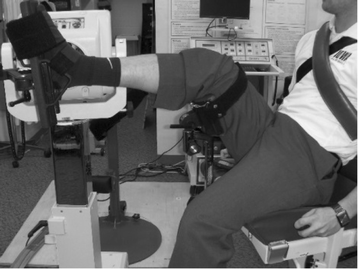3D strength surfaces for ankle plantar- and dorsi-flexion in healthy adults: an isometric and isokinetic dynamometry study
- PMID: 27843491
- PMCID: PMC5105238
- DOI: 10.1186/s13047-016-0174-1
3D strength surfaces for ankle plantar- and dorsi-flexion in healthy adults: an isometric and isokinetic dynamometry study
Abstract
Background: The ankle is an important component of the human kinetic chain, and deficits in ankle strength can negatively impact functional tasks such as balance and gait. While peak torque is influenced by joint angle and movement velocity, ankle strength is typically reported for a single angle or movement speed. To better identify deficits and track recovery of ankle strength after injury or surgical intervention, ankle strength across a range of movement velocities and joint angles in healthy adults is needed. Thus, the primary goals of this study were to generate a database of strength values and 3-dimensional strength surface models for plantarflexion (PF) and dorsiflexion (DF) ankle strength in healthy men and women. Secondary goals were to develop a means to estimate ankle strength percentiles as well as examine predictors of maximal ankle strength in healthy adults.
Methods: Using an isokinetic dynamometer, we tested PF and DF peak torques at five joint angles (-10° [DF], 0° [neutral], 10° [PF], 20° [PF] and 30° [PF]) and six velocities (0°/s, 30°/s, 60°/s, 90°/s, 120°/s and 180°/s) in 53 healthy adults. These data were used to generate 3D plots, or "strength surfaces", for males and females for each direction; surfaces were fit using a logistic equation. We also tested predictors of ankle strength, including height, weight, sex, and self-reported physical activity levels.
Results: Torque-velocity and torque-angle relationships at the ankle interact, indicating that these relationships are interdependent and best modeled using 3D surfaces. Sex was the strongest predictor of ankle strength over height, weight, and self-reported physical activity levels. 79 to 97 % of the variance in mean peak torque was explained by joint angle and movement velocity using logistic equations, for men and women and PF and DF directions separately.
Conclusions: The 3D strength data and surface models provide a more comprehensive dataset of ankle strength in healthy adults than previously reported. These models may allow researchers and clinicians to quantify ankle strength deficits and track recovery in patient populations, using angle- and velocity-specific ankle strength values and/or strength percentiles from healthy adults.
Keywords: 3D strength surfaces; Ankle; Dorsiflexion; Dynamic; Dynamometry; Isokinetic; Isometric; Muscle strength; Peak torque; Plantar-flexion; Static; Torque.
Figures


References
-
- Wolfson L, Judge J, Whipple R, King M. Strength is a major factor in balance, gait, and the occurrence of falls. J Gerontol A Biol Sci Med Sci. 1995;50(Spec No):64–67. - PubMed
-
- Konradsen L, Olesen S, Hansen HM. Ankle sensorimotor control and eversion strength after acute ankle inversion injuries. Am J Sports Med. 1998;26(1):72–77. - PubMed
MeSH terms
Grants and funding
LinkOut - more resources
Full Text Sources
Other Literature Sources
Miscellaneous

